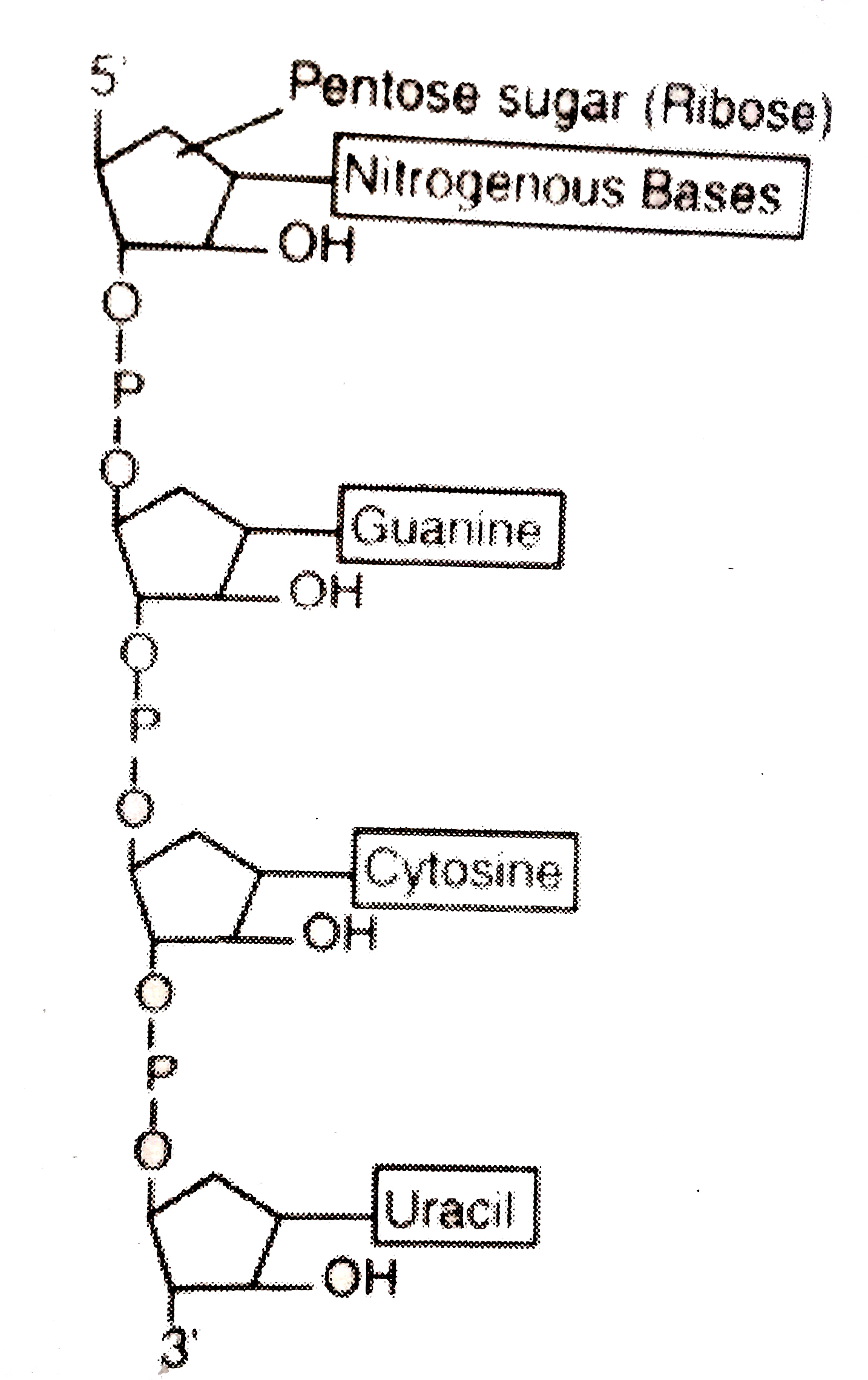Describe the structure of DNA or RNA .
Step-by-Step Text Solution for the Structure of DNA and RNA
Structure of DNA:
1. Polymer Composition: DNA is a polymer made up of deoxyribonucleotides. Each deoxyribonucleotide consists of a deoxyribose sugar, a phosphate group, and a nitrogenous base.
2. Double Helix Formation: DNA has a double helical structure, consisting of two polynucleotide chains that wind around each other.
3. Antiparallel Orientation: The two strands of DNA are oriented in an antiparallel manner. This means that if one strand runs in the 5' to 3' direction, the other strand runs in the 3' to 5' direction.
4. Distance Between Strands: The distance between the two strands of DNA is approximately 20 angstroms.
5. Common Axis: The two strands of DNA have a common central axis around which they twist.
6. Helical Turn: One complete turn of the DNA helix contains about 10 base pairs and spans a distance of 34 angstroms, which is referred to as the pitch of the helix.
7. Base Pairing: The nitrogenous bases are paired through hydrogen bonds: adenine (a purine) pairs with thymine (a pyrimidine) via two hydrogen bonds, while guanine (a purine) pairs with cytosine (a pyrimidine) via three hydrogen bonds. This complementary base pairing is governed by Chargaff's rules.
8. Backbone Structure: The backbone of the DNA molecule is composed of alternating sugar (deoxyribose) and phosphate groups, which are hydrophilic and located on the periphery of the helix. The nitrogenous bases, which are hydrophobic, are stacked in the center.
9. Genetic Material: DNA serves as the genetic material in living organisms, carrying the instructions for the development, functioning, growth, and reproduction of all known living organisms.
Structure of RNA:
1. Single-Stranded: Unlike DNA, RNA is typically single-stranded.
2. Nucleotide Composition: RNA is composed of ribonucleotides, which include ribose sugar, a phosphate group, and nitrogenous bases.
3. Nitrogenous Bases: In RNA, thymine is replaced by uracil, which pairs with adenine.
4. Lack of Complementarity: RNA does not have a complementary base pairing rule like DNA, as it is usually single-stranded.
5. Function in Protein Synthesis: RNA plays a crucial role in the process of transcription (copying genetic information from DNA) and translation (synthesizing proteins based on that information).
1. Polymer Composition: DNA is a polymer made up of deoxyribonucleotides. Each deoxyribonucleotide consists of a deoxyribose sugar, a phosphate group, and a nitrogenous base.
1. Single-Stranded: Unlike DNA, RNA is typically single-stranded.
Topper's Solved these Questions
- BIOMOLECULES BOOK - PRADEEPCHAPTER - BIOMOLECULES EXERCISE - ANALYTICAL QUESTIONS WITH ANSWERS
19 Videos
- BIOMOLECULES BOOK - PRADEEPCHAPTER - BIOMOLECULES EXERCISE - PRACTICE QUESTIONS (MULTIPLE CHOICE QUESTION )
96 Videos
- BIOMOLECULES BOOK - PRADEEPCHAPTER - BIOMOLECULES EXERCISE - ADDITIONAL QUESTIONS (SHORT ANSWER QUESTIONS)
99 Videos
- BIOLOGICAL CLASSIFICATIONBOOK - PRADEEPCHAPTER - BIOLOGICAL CLASSIFICATIONEXERCISE - Practice Questions (II. Assertion-Reason Type Questions)
8 Videos
- BODY FLUIDS AND CIRCULATIONBOOK - PRADEEPCHAPTER - BODY FLUIDS AND CIRCULATIONEXERCISE - Practice Questions (II. Assettion-Resson Type Questions)
11 Videos
Similar Questions
Knowledge Check
In the structure of DNA, -OH group from which carbon atom is absent compared to RNA
A2B3C4D5In structure of D.N.A and R.N.a nucleotides are joined together by phosphodiester linkage between
A5' and 2' carbon atoms of the pentose sugarB5' and 3' carbon atoms of the petose suggarC5' and 1' carbon atoms of pentose sugarD3' and 1' carbon atoms of pentose sugar
Describe the structure of an RNA polynucleotide chain having four different types of nucleotides.

View Solution(a) Describe the structure and function of a t-RNA molecules . Why is it referred to as an adapter molecules ?
(b) Explain the process of splicing of hn - RNA in a eukaryotic cell.
View SolutionDescribe the transcription of RNA from DNA.
View SolutionSketch and explain the structure of DNA and various type of RNA.
View SolutionExplain the structure of t-RNA with the help of a diagram. Describe its role in the process of translation.
View SolutionRibose in RNA and deoxyribose in DNA differ in the structure around which carbonatom?
View Solution
